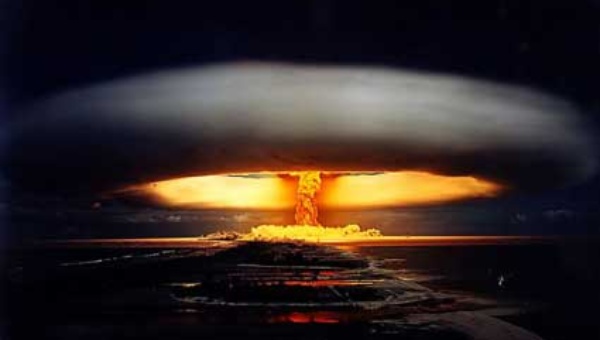The Nuclear Age at Seventy
WEAPONS OF MASS DESTRUCTION, 6 Jul 2015
David Krieger – Nuclear Age Peace Foundation
The first explosion of a nuclear device took place at Alamogordo, New Mexico on July 16, 1945. Just three weeks later, the United States dropped an atomic bomb on the Japanese city of Hiroshima and three days after that on the Japanese city of Nagasaki. The new weapons had devastating power, killing approximately 100,000 people immediately in the two cities and another 100,000 people by the end of 1945.
Since these bombings brought the world into the Nuclear Age, the human future and that of other forms of life have been at risk. Never before did humankind have the power to destroy itself, but that completely changed in the Nuclear Age. By our own scientific and technological cleverness, we humans had created the means of our own demise. Our technological capacity for destruction had exceeded our spiritual capacity to work together and cooperate to end the threat that these weapons posed to our common future.
After the bombings of the two Japanese cities, the United States almost immediately entered into a nuclear arms race with itself. In 1946, when the US was the only nuclear-armed country in the world, it began atmospheric nuclear testing in the Marshall Islands, then a United Nations Trust Territory that the US had agreed to administer. The US broke the bond of trust by testing 67 nuclear weapons in the Marshall Islands, with an explosive power equivalent to detonating 1.6 Hiroshima bombs daily for 12 years.
In the decades that followed, other countries would develop nuclear arsenals. These included: the USSR (now Russia), UK, France, China, Israel, India, Pakistan and North Korea. On numerous occasions the nuclear-armed countries came close to using nuclear weapons by accident, miscalculation or design. The most serious of these near disasters was the Cuban Missile Crisis, which went on for 13 days in 1962, while the world stood on the brink of nuclear war.
At the height of the nuclear arms race in 1986, there were more than 70,000 nuclear weapons in the world. There were more nuclear weapons than there were targets for them. With the end of the Cold War in the early 1990s, the number of nuclear weapons began to fall and since then the world, primarily the US and Russia, has shed over 50,000 nuclear weapons.
Today there are approximately 16,000 nuclear weapons in the world, with over 90 percent in the arsenals of the US and Russia. Some 1,800 of these remain on hair-trigger alert, ready to be fired within moments. These are still insane numbers, with species- ending potential. Yet, strangely, most people on the planet do not think much about nuclear dangers.
One group of people, though, the survivors of Hiroshima and Nagasaki, still think a lot about these dangers. These survivors, or hibakusha (as they are known in Japan), have witnessed the horrors of nuclear weapons at close hand. They have seen the death and destruction caused by the relatively small nuclear weapons used at Hiroshima and Nagasaki. They speak out with the moral certainty that they do not want their past to become anyone else’s future.
All nine nuclear-armed countries are engaged in modernizing their nuclear arsenals. Together they are spending $100 billion annually on them. The US alone is planning to spend $1 trillion over the next three decades on modernizing its nuclear arsenal. It is a waste of precious resources that should be reallocated to meeting human needs for food, water, shelter, healthcare, education, a clean environment and repaired infrastructure.
The grand bargain of the nuclear Non-Proliferation Treaty is that the non-nuclear-armed states agreed not to acquire nuclear weapons, and the nuclear-armed states agreed to negotiate in good faith for the elimination of their nuclear arsenals. The goal is a level playing field, with no countries possessing nuclear weapons. The problem with the bargain is that the nuclear-armed countries are not holding up their end.
Lawsuits against all nuclear-armed nations To set this right, the Republic of the Marshall Islands has brought lawsuits against the nine nuclear-armed countries, calling on the International Court of Justice (ICJ) to declare them in breach of their obligations and order them to commence the promised negotiations. Because the US is such an important player and does not accept the compulsory jurisdiction of the ICJ, a separate lawsuit was brought against it in US federal court.
If the people of the Marshall Islands can demonstrate such boldness and courage, so can the rest of us. It is time for action to demand a nuclear weapons-free world. It is time to challenge hubris with wisdom, and complacency with compassion. Nuclear weapons are powerful, but the human heart is more powerful. As Pope Francis said, we need a “conversion of hearts.”
It is time to join with the hibakusha in demanding a world free of nuclear weapons. The world has waited for 70 years to end the nuclear weapons era. The next decades may not be so kind to humanity. We must act now, while we still can, to end the nuclear weapons threat to humanity and all life.
___________________________________
David Krieger is President of the Nuclear Age Peace Foundation and a member of the TRANSCEND Network for Peace, Development and Environment. He has a new collection of poems entitled Wake Up. For more visit the Nuclear Age Peace Foundation website: www.wagingpeace.org.
This article was originally published by the Hiroshima Peace Media Center.
Go to Original – wagingpeace.org
DISCLAIMER: The statements, views and opinions expressed in pieces republished here are solely those of the authors and do not necessarily represent those of TMS. In accordance with title 17 U.S.C. section 107, this material is distributed without profit to those who have expressed a prior interest in receiving the included information for research and educational purposes. TMS has no affiliation whatsoever with the originator of this article nor is TMS endorsed or sponsored by the originator. “GO TO ORIGINAL” links are provided as a convenience to our readers and allow for verification of authenticity. However, as originating pages are often updated by their originating host sites, the versions posted may not match the versions our readers view when clicking the “GO TO ORIGINAL” links. This site contains copyrighted material the use of which has not always been specifically authorized by the copyright owner. We are making such material available in our efforts to advance understanding of environmental, political, human rights, economic, democracy, scientific, and social justice issues, etc. We believe this constitutes a ‘fair use’ of any such copyrighted material as provided for in section 107 of the US Copyright Law. In accordance with Title 17 U.S.C. Section 107, the material on this site is distributed without profit to those who have expressed a prior interest in receiving the included information for research and educational purposes. For more information go to: http://www.law.cornell.edu/uscode/17/107.shtml. If you wish to use copyrighted material from this site for purposes of your own that go beyond ‘fair use’, you must obtain permission from the copyright owner.
Read more
Click here to go to the current weekly digest or pick another article:
WEAPONS OF MASS DESTRUCTION:

